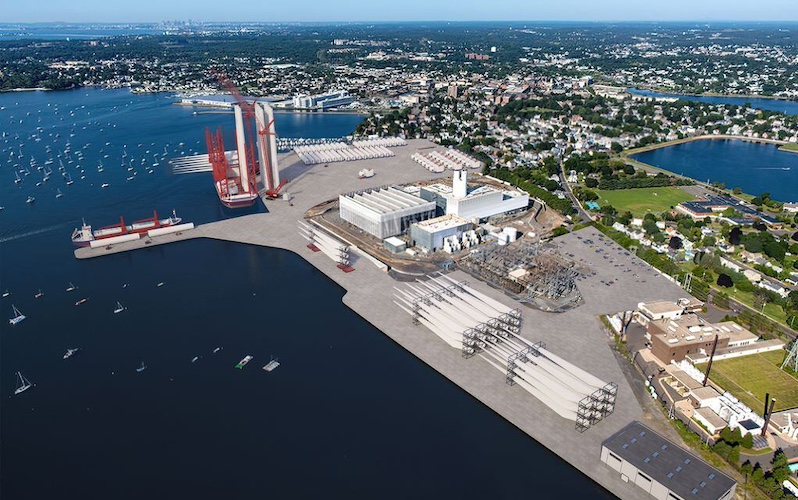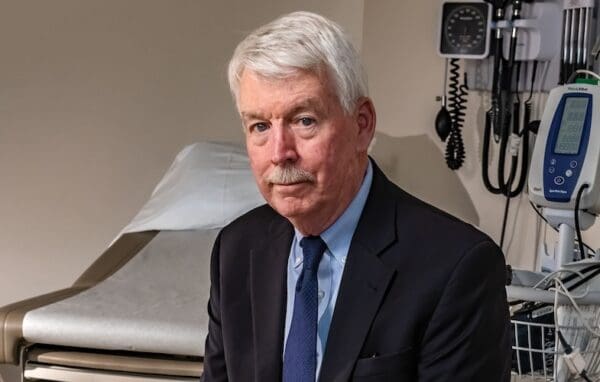
The Salem Wind Port will replace an old coal-fired power plant, a transformation attesting to the power and need for community action. Rendering: Vineyard Wind.
As my ferry ride approaches Salem, Massachusetts, I am greeted by calming waters and a gentle breeze that carries a fresh, salty scent. Along the shore, the city’s landscape unfolds. This port, once an area of industrial blight, will soon become a launch pad for clean offshore wind energy. But as I observe the construction site of the new facility, my thoughts turn not only to this port’s future but to the determination of Salem residents. Their efforts and steadfast advocacy are moving this offshore wind launching hub forward in a manner that will benefit those living in Salem.
I worked with Salem Alliance for the Environment (SAFE), a local community group, to negotiate with the mayor of Salem and an offshore wind developer a legal contract known as a Community Benefits Agreement. When negotiated and implemented fairly, these agreements are valuable tools that allow communities to see practical gains from local development. In this case, SAFE was dedicated to seeing that Salem – a city with significant numbers of people of color, those who do not speak English as a primary language, and low-income residents – reap direct rewards from the proposed project.
The process was not perfect. Yet, the lessons learned can help shed light on how to approach permitting of energy infrastructure in environmental justice communities. Here are some of the lessons we learned.
1. Form a Strong Coalition
Community groups need to come together with energy developers to ensure an inclusive negotiation process that works for everyone.
SAFE, an environmental group dedicated to an equitable transition to clean energy, heard that Crowley Wind Services was converting the lot of an old coal-fired power plant to an offshore wind port. SAFE did not want past mistakes that ignored their voices to be repeated. The group wanted clean energy infrastructure in Salem with the community at the heart of negotiations with the developer.
The group created a coalition, Salem Offshore Wind Alliance (SOWA), with surrounding neighborhood associations and civic groups to establish fundamental goals in the negotiation process. SAFE and the broader coalition wanted residents most impacted by past polluting energy infrastructure, like the coal-fired plant, to see concrete changes that would benefit their lives. This included access to jobs, funding of educational programs, and a commitment for the community to stay involved.
I helped represent the coalition in negotiations with the mayor’s office and Crowley. Yet, SAFE/SOWA’s effort to bring key stakeholders together to express community concerns was critical to making their voices heard.
2. Understand the Benefits and Burdens of Projects
Local groups must be aware of the benefits and burdens of locating a project in their community. They must do careful research to ensure that any requests they make from the developer have the most beneficial impact.
From the start, the Salem community supported offshore wind development. They knew the Commonwealth needed this technology to reduce carbon pollution and produce clean energy. In Massachusetts, reductions in climate pollution are required by the Global Warming Solutions Act, the Roadmap Law, and the state’s climate plan.
SAFE/SOWA also knew the project could make a real difference in meeting state and federal clean energy goals. The offshore wind port could help power more than 3.5 million homes. But all that clean energy could not come at the expense of the quality of life in Salem. That’s why residents asked the developer to electrify the port. This means that while docked, ships will have to turn off diesel engines and use electricity to reduce toxic emissions.
3. Include the Community from the Start
Negotiations with developers must involve coalition groups from the beginning. After all, community benefit agreements should aim to restore power to marginalized groups by benefiting them directly from the development process.
After months of back-and-forth conversations and the signing of a memorandum of understanding, Salem’s mayor agreed to include SAFE and the coalition in negotiations. The mayor allowed us to review the provisions in the agreement and suggest topics for inclusion.
While the community did not sign the agreement in Salem, communities negotiating these agreements should aim to sign the contract. That can help them have direct legal negotiating power.
4. Advocate for Specific, Enforceable Provisions
Coalition groups must have a clear vision of what they want from the developer.
In Salem, we successfully negotiated with Crowley and the mayor’s office because SAFE/SOWA had that vision. As a result, the community received the agreement positively.
For example, Crowley committed to spend $9 million in direct funding to the community, representing around 3% of the total project cost. To name a few provisions, the company committed to:
- hiring from the local community
- strategizing to achieve 100% port electrification by 2040, and
- contributing to Salem public schools to educate the community about the offshore wind industry
5. Leverage State and Federal Policy
When working with city officials and developers, coalition groups should turn to state and federal laws and policies to garner support for their inclusion.
That’s what we did in Salem. Federal guidelines on community benefit agreements hold that the process should be inclusive, enforceable, transparent, and include coalition-building.
While no state law requires that the community groups be included in the agreement, many states like Massachusetts are exploring ways to guarantee that benefits flow directly to residents. These benefits can take the form of community benefits agreements, tax credits, or utility bill reductions.
Moving Forward
When I boarded the ferry back to Boston, the fading view of Salem’s harbor allowed me to reflect on the community’s resilience and dedication. Residents’ collective efforts have transformed a once-industrial site into a landmark of our clean energy future. This transformation attests to the power and need for community action to achieve a just transition for all.



